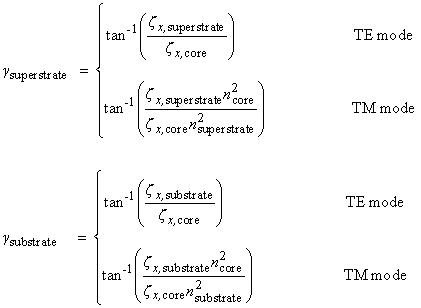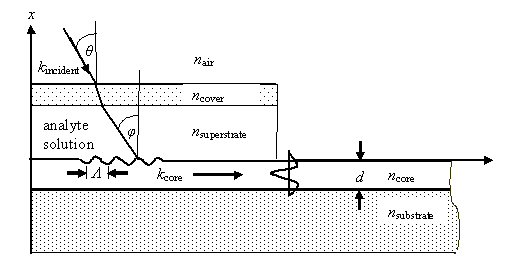|
1. Methods used in the determination of the core film refractive index, ncore
|
|
Constructor
| |
public GratingCoupler()
|
|
Enter core thickness/es and coupling angle/s
| Enter TE mode data for a single measurement |
public void enterTEmodeData(double thickness, double couplingAngle, double modeNumber)
|
|
public void enterTEmodeData(double thickness, double couplingAngle, double error, double modeNumber)
|
| Enter TM mode data for a single measurement |
public void enterTMmodeData(double thickness, double couplingAngle, double modeNumber)
|
|
public void enterTMmodeData(double thickness, double couplingAngle, double error, double modeNumber)
|
| Enter TE mode data for a range of core thicknesses |
public void enterTEmodeData(double[] thicknesses, double[] couplingAngles, double[] modeNumbers)
|
|
public void enterTEmodeData(double[] thicknesses, double[] couplingAngles, double[] errors, double[] modeNumbers)
|
| Enter TM mode data for a range of core thicknesses |
public void enterTMmodeData(double[] thicknesses, double[] couplingAngles, double[] modeNumbers)
|
|
public void enterTMmodeData(double[] thicknesses, double[] couplingAngles, double[] errors, double[] modeNumbers)
|
|
Wavelength
| Set the wavelength |
public void setWavelength(double wavelength)
|
|
Grating
| Set the grating pitch, Λ |
public void setGratingPitch(double pitch)
|
|
Enter the TE mode grating orders, m
|
public void setTEmodeGratingOrder(int[] order)
|
|
Enter the TM mode grating orders, m
|
public void setTMmodeGratingOrder(int[] order)
|
|
Set Refractive Indices
| Set substrate refractive index |
public void setSubstrateRefractiveIndex(double refractiveIndex)
|
| Set superstrate refractive index |
public void setSuperstrateRefractiveIndex(double refractiveIndex)
|
|
Calculated Core Refractive Index
| Get mean refractive index of the core layer |
public double getCoreFilmRefractiveIndex()
|
|
public double getMeanCoreFilmRefractiveIndex()
|
| Get standard deviation of the mean refractive index of the core layer |
public double getStandardDeviationCoreFilmRefractiveIndex()
|
| | |
| Get mean TE mode refractive index of the core layer |
public double getMeanTEmodeCoreFilmRefractiveIndex()
|
| Get standard deviation of the mean TE mode refractive index of the core layer |
public double getStandardDeviationTEmodeCoreFilmRefractiveIndex()
|
| | |
| Get mean TM mode refractive index of the core layer |
public double getMeanTMmodeCoreFilmRefractiveIndex()
|
| Get standard deviation of the mean TM mode refractive index of the core layer |
public double getStandardDeviationTMmodeCoreFilmRefractiveIndex()
|
| | |
| Get the TE mode refractive indices for the core layer thicknesses |
public double[] getTEmodeCoreFilmRefractiveIndices()
|
| Get the TM mode refractive indices for the core layer thicknesses |
public double[] getTMmodeCoreFilmRefractiveIndices()
|
|
Effective refractive indices
| Get the TE mode experimental effective refractive indices |
public double[][] getTEmodeExperimentalEffectiveRefractiveIndices()
|
| Get the errors in the TE mode experimental effective refractive indices |
public double[][] getTEmodeEffectiveRefractiveIndicesErrors()
|
| Get the TM mode experimental effective refractive indices |
public double[][] getTMmodeExperimentalEffectiveRefractiveIndices()
|
| Get the errors in the TM mode experimental effective refractive indices |
public double[][] getTMmodeEffectiveRefractiveIndicesErrors()
|
| Get the TE mode calculated effective refractive indices |
public double[][] getTEmodeCalculatedEffectiveRefractiveIndices()
|
| Get the TM mode calculated effective refractive indices |
public double[][] getTMmodeCalculatedEffectiveRefractiveIndices()
|
|
Plot fitted dispersion curve
| |
public void plotFittedDispersionCurves(String graphTitle)
|
| |
public void plotFittedDispersionCurves()
|
2. Methods used in calculating the superstrate (analyte solution) refractive index,
nsuperstrate
|
|
Constructor
| |
public GratingCoupler()
|
|
Enter core thickness/es and coupling angle/s
| Enter TE mode data for a single measurement |
public void enterTEmodeData(double thickness, double couplingAngle, double modeNumber)
|
|
public void enterTEmodeData(double thickness, double couplingAngle, double error, double modeNumber)
|
| Enter TM mode data for a single measurement |
public void enterTMmodeData(double thickness, double couplingAngle, double modeNumber)
|
|
public void enterTMmodeData(double thickness, double couplingAngle, double error, double modeNumber)
|
| Enter TE mode data for a range of core thicknesses |
public void enterTEmodeData(double[] thicknesses, double[] couplingAngles, double[] modeNumbers)
|
|
public void enterTEmodeData(double[] thicknesses, double[] couplingAngles, double[] errors, double[] modeNumbers)
|
| Enter TM mode data for a range of core thicknesses |
public void enterTMmodeData(double[] thicknesses, double[] couplingAngles, double[] modeNumbers)
|
|
public void enterTMmodeData(double[] thicknesses, double[] couplingAngles, double[] errors, double[] modeNumbers)
|
|
Wavelength
| Set the wavelength |
public void setWavelength(double wavelength)
|
|
Grating
| Set the grating pitch, Λ |
public void setGratingPitch(double pitch)
|
|
Enter the TE mode grating orders, m
|
public void setTEmodeGratingOrder(int[] order)
|
|
Enter the TM mode grating orders, m
|
public void setTMmodeGratingOrder(int[] order)
|
|
Set Refractive Indices
| Set substrate refractive index |
public void setSubstrateRefractiveIndex(double refractiveIndex)
|
| Set core film refractive index |
public void setCoreLayerRefractiveIndex(double refractiveIndex)
|
|
Calculated Superstrate Index
| Get mean refractive index of the superstrate (analyte solution) |
public double getSuperstrateRefractiveIndex()
|
|
public double getAnalyteSolutionRefractiveIndex()
|
| Get standard deviation of the refractive index of the superstrate (analyte solution) |
public double getStandardDeviationSuperstrateRefractiveIndex()
|
|
public double getStandardDeviationAnalyteSolutionRefractiveIndex()
|
3. Methods used in calculating and plotting a theoretical effective refractive index,
neff, versus core thickness, d, dispersion curve
|
|
Constructor
| |
public GratingCoupler()
|
|
Wavelength
| Set the wavelength |
public void setWavelength(double wavelength)
|
|
Set Refractive Indices
| Set substrate refractive index |
public void setSubstrateRefractiveIndex(double refractiveIndex)
|
| Set superstrate refractive index |
public void setSuperstrateRefractiveIndex(double refractiveIndex)
|
| Set core film refractive index |
public void setCoreLayerRefractiveIndex(double refractiveIndex)
|
|
Theoretical dispersion curve
|
Calculate theoretical TE mode dispersion curve |
public double[][] dispersionCurveTE(double lowThickness, double highThickness, int numberOfPoints, double modeNumber)
|
| Calculate theoretical TM mode dispersion curve |
public double[][] dispersionCurveTM(double lowThickness, double highThickness, int numberOfPoints, double modeNumber)
|
| Plot theoretical TE mode dispersion curve |
public double[][] plotDispersionCurveTE(double lowThickness, double highThickness, int numberOfPoints, double modeNumber, String graphTitle)
|
public double[][] plotDispersionCurveTE(double lowThickness, double highThickness, int numberOfPoints, double modeNumber)
|
| Plot theoretical TM mode dispersion curve |
public double[][] plotDispersionCurveTM(double lowThickness, double highThickness, int numberOfPoints, double modeNumber, String graphTitle)
|
public double[][] plotDispersionCurveTM(double lowThickness, double highThickness, int numberOfPoints, double modeNumber)
|






